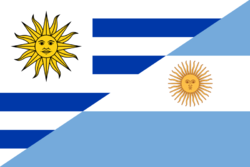Overview
Current data estimates the figure of Uruguayans in Argentina at over 200,000 in 2017. [3]
Many Uruguayan-born persons live in Argentina, for various reasons. Both countries share the same language, culture and ethnicity and their populations bear striking similarities; the historical origins of both nations is common (part of the Viceroyalty of the River Plate, Spanish Empire); both countries are members of MERCOSUR, there is no need for special migration documents, and circulation is relatively easy. Argentina has a much bigger economy, which has always attracted Uruguayans in search of opportunities; the cultural scene is intense, so many talented Uruguayan actors and entertainers have succeeded in their artistic careers in Argentina. And last, but not least, Uruguayans value and praise Argentina as a nice tourist and holidaying destination; especially as a "shopping paradise". [4]
Uruguayan residents in Argentina have their own institutions, for instance, the Consultative Council in Buenos Aires [5] or the Center of Uruguayan Residents in Mar del Plata "José Gervasio Artigas". [6]
History
The causes of Uruguayan immigration to Argentina are several. Among these, in addition to the 1973 Uruguayan coup d'état are: improved living conditions, job search, fleeing the economic, socio-cultural similarity with Argentina, among others. Most settled throughout the Argentine territory, but mainly in the City of Buenos Aires and the surrounding metropolitan area and the rest of the Buenos Aires Province.
A notable group of Uruguayan humorists developed their career on both countries, Argentina and Uruguay: Ricardo Espalter, Raimundo Soto, Eduardo D'Angelo, Julio Frade, Enrique Almada. During the 1960s, 1970s and 1980s they commuted frequently to record famous television comedies: Jaujarana , Hupumorpo , Comicolor , Híperhumor .
This page is based on this
Wikipedia article Text is available under the
CC BY-SA 4.0 license; additional terms may apply.
Images, videos and audio are available under their respective licenses.






